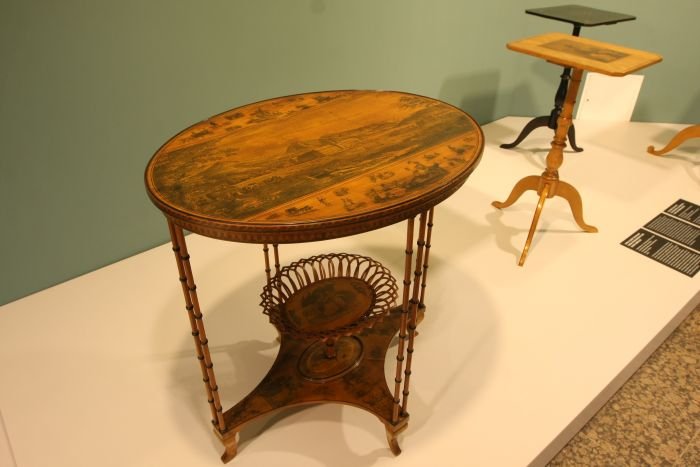It is seldom that the largest, most centrally placed and intricately staged object in an exhibition isn't the central focus of that exhibition, but a conduit which introduces and guides the exhibition.
Something you could ignore, but really shouldn't.
However such is the case with the Kunstgewerbemuseum Berlin's new exhibition Inside Out. Understanding the art of furniture making
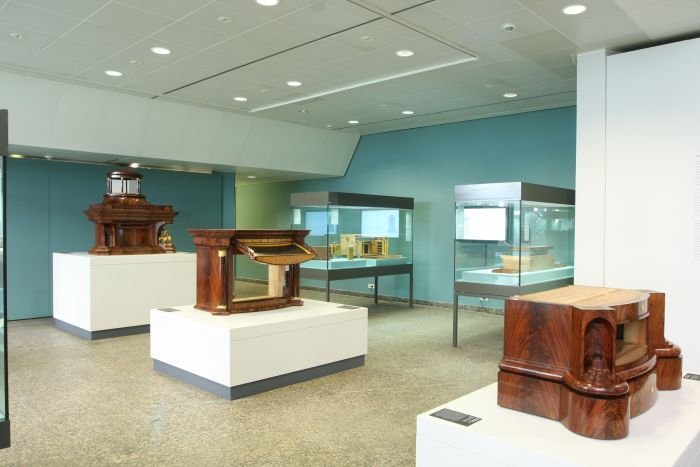
Although it's is widely accepted in terms of science or technology that if you want to understand something you take it apart, in context of furniture one is normally expected to understand an object from viewing it in its constructed state. Regularly without touching it. Far less using it in that manner which its designer intended it to be used. Which in the majority of cases isn't possible. Yet we're expected to.
As a museual antidote to such, Inside Out is based around an "exploded" escritoire/secretary created by Berlin ébéniste Joseph Schneevogl in (ca.) 1835. Not literally exploded, that would be majestically unhelpful, rather as an object it has been physically deconstructed into its component parts, a deconstruction which bequeaths the component parts an independence from the whole, and leading the exhibition off into further explorations and discourses. And thereby ever further from the escritoire/secretary.
The most direct exploration and discourse arising from the deconstruction of the escritoire/secretary is that of the art of furniture construction. At the opening of Inside Out curator Dr. Achim Stiegel commented that furniture making has lost its place in society. While we're in no way in any position to even consider disagreeing with a Dr. Stiegel, we would temper such a position with the comment that while certainly for many (a majority?) of consumers the nature of the construction of a piece of furniture, the intelligence and elegance with which the composition is realised, may be as worthy of as much consideration as the source of facebook news story or the reasons so many Californian tech-conglomerates are so keen on autonomous cars, that we unquestionably live in an increasingly visual world where consumption is of images and semantics more than objects, but that despite that, there are still many designers and manufacturers who take furniture construction very seriously: the intention must be to explain to those who don't, not only why they should, why the art of furniture construction is relevant, but the very real joy one can discover in well-considered and realised objects. An intention at the core of Inside Out
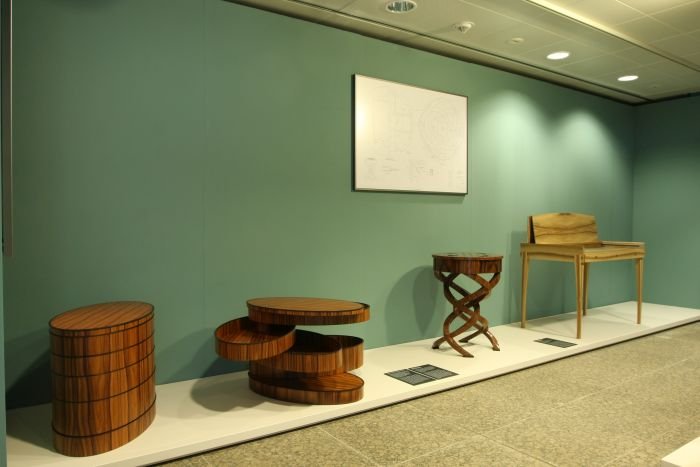
In addition, the deconstruction of the secretary allows for an exploration and discourse on the nature of the object itself and the context in which it was created, for all that it is a veneered object. A mahogany veneered object. And thereby an object which exists in context of an important period of furniture design history, the rise of veneer in the early 19th century, something discussed previously in context of the V&A Museum London's 2017 exhibition Plywood; and also as an object which exists in context of the, still troublesome, history of colonial era tropical wood harvesting and the associated social, economic and environmental issues.
Beyond such historical aspects Inside Out also explores current developments in veneer technology, if you will the current state of the ébéniste's craft, and most prominently the so-called 3D-Veneer developed in Dresden, distributed today by Danzer, and which allows for the creation of more complex moulded veneer objects than was previously the case. And a material whose functionality is ably demonstrated in Inside out through the curves, dips and roundings of Thomas Pedersen's Stingray chair for Fredericia, but also through a 2010 Hermann Miller version of the Eames' S-shell in moulded Santos-Palisander: something that wouldn't have been possible in 1950 when the fibreglass version was realised. More traditional aspects of contemporary veneering, of the contemporary ébéniste's art, being found in a series Meisetrstücke by Berlin craftsfolk and objects created by students at the Berufsschule für Holzschnitzerei und Schreinerei in Berchtesgaden.
And while in no sense a chronological exhibition, this linking of the historical with the contemporary is one of the underlying themes of the exhibition, for all the comparison of the 1835 secretary with contemporary furniture. Do such and you'll be taken on a journey of questions as to how much from then is retained in contemporary furniture design/construction? How much have we lost in terms of furniture design/construction? Why have we lost that which we've lost? Why have we retained that which we have retained? But for all an analysis of the 1835 Schneevogl secretary with its secret compartments, intricate mechanisms and well thought through extended functionalities, tends to support the position that we live in times when people increasingly don't care that much about the art of furniture making, or perhaps better put that as a society we've stopped demanding good furniture making, even interesting furniture making. Personally we haven't, we still demand it and dance for joy where we find it, for it does exist. But isn't as universal as it should be, as it arguably once was. Viewing the secretary we were very much reminded of the objects presented in the Grassi Leipzig's 2014 exhibition, Exclusive Carpentry Works From Leipzig: F.G. Hoffmann, works which although a century older than Schneevogl's had the same sense of adventure, same joy at their own existence, an almost theatrical understanding of furniture, of furniture as a companion to life.
And a reminder as to what an inherent part of the human psyche desk drawers are.
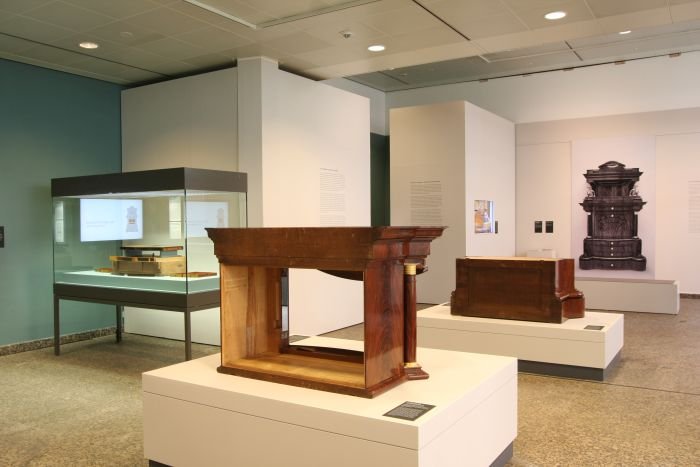
In addition to the discussions leading directly from the secretary Inside Out also finds space for forays into the botany of mahogany, more expansive variations on veneering techniques and Berlin furniture production in the 19th century. Which is an awful lot of exhibition. And an awful lot of exhibition in a relatively small space, and told with a relatively small number of objects, we didn't count but aside from the many, many parts of the deconstructed secretary we'd be surprised if the rest of exhibition topped 50 objects; and therefore is a discussion and exploration told with an audacious brevity. At times you find yourself disbelievingly coming to the end of a section, desperate for more information, other perspectives, extended views. But they don't come.
And that is also the secret to the exhibition, is necessary in context of the exhibitions function. Very much wider than it is deep the pace of Inside Out's narrative stops it becoming bogged down in one area but rather keeps it moving along, keeps you on your toes and thereby achieving an exhibition which allows for an entertaining and informative introduction to its subject(s) But no more. Each section could/should be an exhibition in its own right, Inside Out is the exhibition which explains the connections between those exhibitions. One could almost argue is a prologue. And thereby, and as one would wish from any exhibition, provides more than enough scope, impetus, and inspiration for further investigation on your own.
And also highlighting a few possible future exhibition ideas for the Kunstgewerbemuseum. Tropical woods in furniture production would be our suggestion.
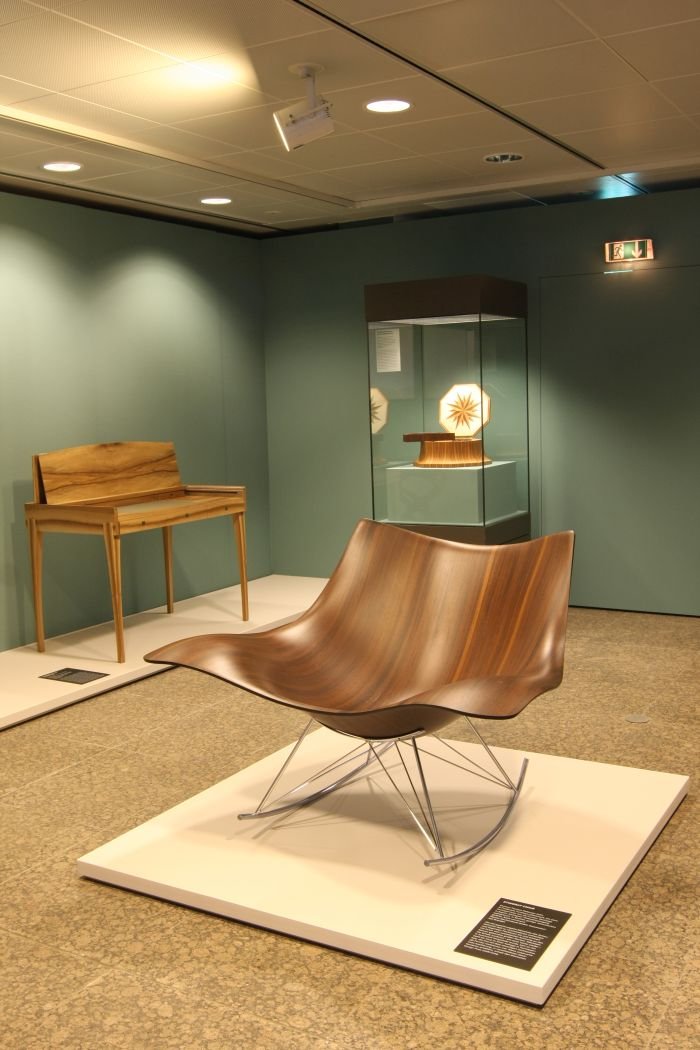
The central conceit with the exploded secretary largely defines the opening scenography, ensures that it is, as with the secretary, open and approachable, the later sections being self-contained enough to ensure that the exhibition flows its course without interruption.
While on the one hand very much an exhibition for a younger generation, for those who've not yet started considering furniture and who, therefore, are likely to be more receptive to the idea of furniture as more than a visual art, as an exhibition Inside Out is arguably primarily one for those with an interest in the physical factors pertaining to the construction of furniture, which we'd argue should be you all, know from experience it's not, maintain you should be, and that for all when it involves furniture objects which as with the Schneevogl secretary exist in context of very specific social, economic, technical and political contexts. Exist as moments in the (hi)story of furniture design, and therefore have a relevance for contemporary furniture design. And furniture construction.
An importance and relevance neatly underscored by the concisely detailed bilingual English/German texts, while a particularly pleasing touch is a leaflet which directs visitors to further examples of veneer furniture elsewhere in the museum's permanent collection exhibition, be that from the Middle Ages, Baroque, Jugendstil. Or in Inside Out itself where there is an escritoire/secretary created by Berlin ébéniste Joseph Schneevogl in (ca) 1835. Which sounds like a good place to start exploring the art of furniture making.
Inside Out. Understanding the art of furniture making runs at the Kunstgewerbemuseum Berlin, Matthäikirchplatz, 10785 Berlin until Sunday February 24th
And after visiting Inside Out you can also explore the current Design Views showcase; until November 21st FI AK FALE _ HIER UND DORT by the Berlin fashion designer Buki Akomolafe and from 28.11 WertelOberfell WIP - Work In Progress
Full details on Inside Out and Design Views, and indeed the Kunstgewerbemuseum Berlin can be found at www.smb.museum/kunstgewerbemuseum
